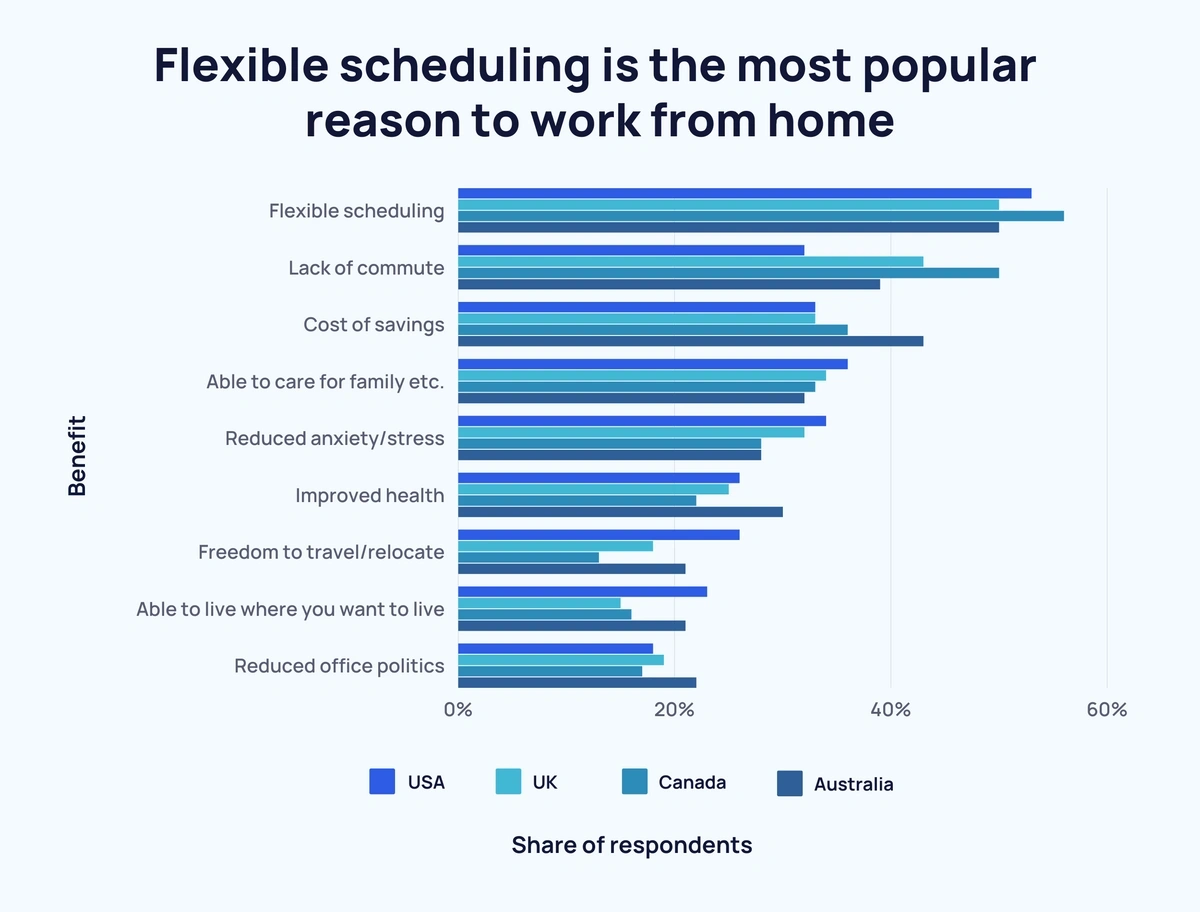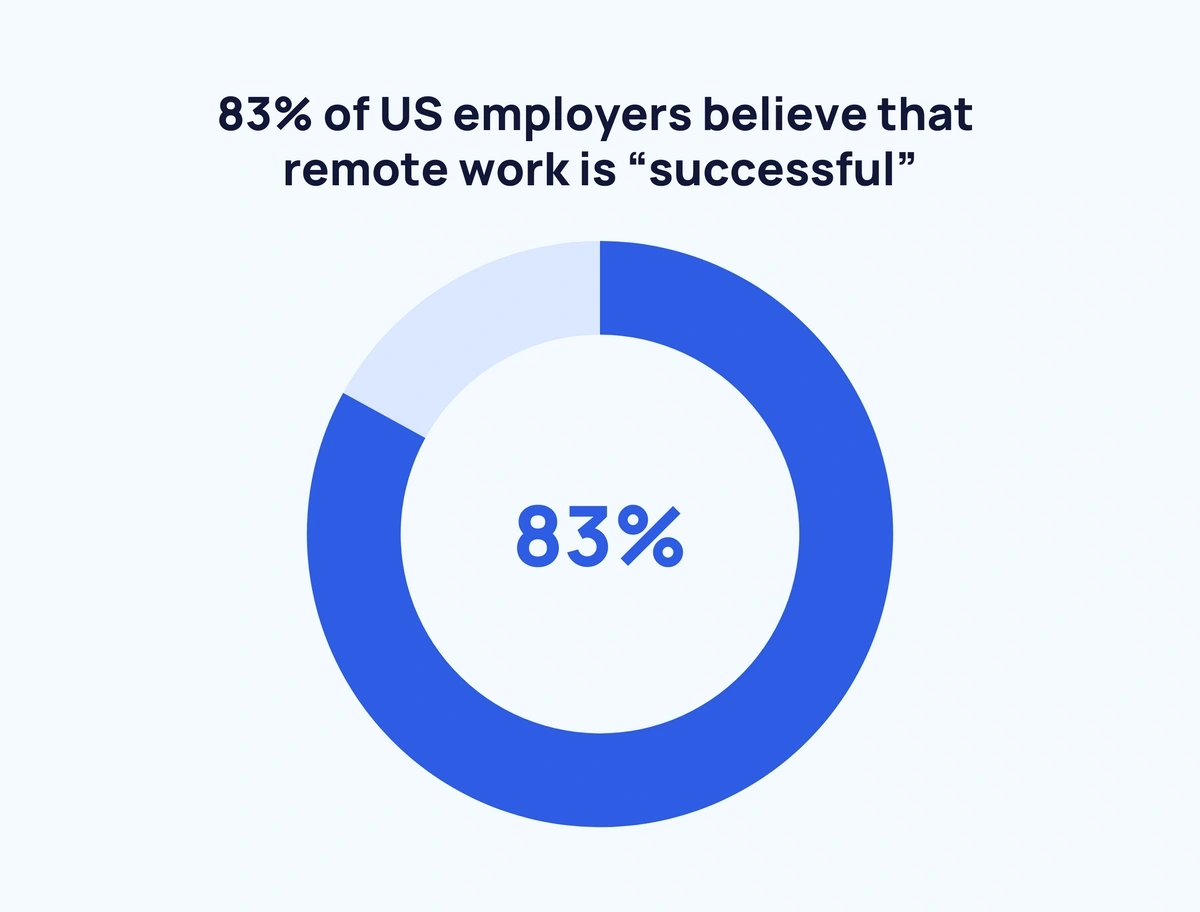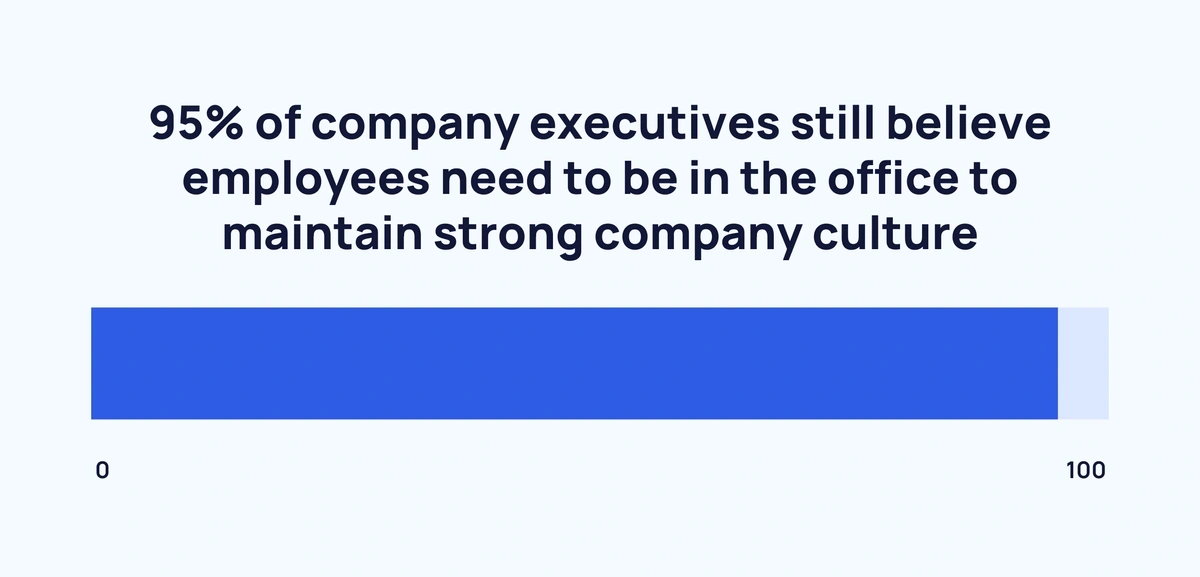
40+ Fascinating Remote Work Statistics (2025)
This article is a list of 40+ fascinating remote work statistics for 2024.
The remote work and work-from-home (WFH) trends have become increasingly prevalent in recent years, with both of these trends accelerated by the pandemic.
If you'd like to learn more about the current state of remote work, check out this up-to-date list of remote work stats.
Contents
- Remote Work Growth Stats
- WFH Tool Use Stats
- Stats On Employee Attitudes Towards Remote Work
- Employer Attitudes To Remote Work Stats
- Impact Of The Pandemic On WFH
- Future Of Remote Working Stats
Top 2025 Remote Work Stats
- Over 80% of people work from home
- Nearly 2 in 3 workers are fully remote
- Around 9 in 10 people enjoy working from home
- More than 50% of adult professionals believe that productivity is the biggest advantage of WFH
- Flexible scheduling is the top benefit to remote working
- Not being able to unplug is the biggest WFH challenge
Overall Remote Work Stats
Around 4 in 5 work from home (Buffer)
The number of people working from home has soared in recent years.
In 2022, 59% of respondents said they work from home. In the space of a year, that figure jumped to 82%.
Here's the workplace breakdown:
- Home – 82%
- Office – 9%
- Coworking space – 5%
- Coffee shop – 2%
- Other – 2%
Approximately 2 in 3 workers are now fully remote (Buffer)
The number of fully remote workers continues to rise, growing from 49% in 2022 to 64% in 2023.
The hybrid categories are as follows:
- Hybrid and remote-first – 18%
- Hybrid and office-occasional – 9%
- Hybrid and office-first - 9%
Around 1 in 3 people who WFH have a dedicated office space (Buffer)
When asked where people WFH, 37% said they use a home office.
Meanwhile, 21% work from their bedroom and 20% work from their living room.
14% of participants say they move between rooms when working from home.
More than half of remote workers started working from home since 2020 (GitLab)
A 2020 survey found that 56% of remote workers had been working from home for less than a year. Which shows just how quickly remote work has gone mainstream.
A further 21% of respondents had begun working from home less than 5 years ago. And an additional 14% of remote workers had begun working from home between 2010 and 2020.
The growing proportion of new remote workers reflects the necessity of WFH for many employees.
Flexible scheduling is the most popular reason to WFH (GitLab)
Of the 9 listed benefits of working from home, “flexible scheduling” is the most popular reason to work remotely. This is the case in the US, the UK, Canada, and Australia, all of which received a 50% or larger share of respondent votes.
The next most popular reason to work remotely varied across countries. In the UK and Canada, it is a “lack of commute”.
While in the US it is the ability to “care for family/pets/relatives”. And in Australia, it is the “cost of savings”.
Here are the full results of the 2020 survey:
| Benefit | USA respondents | UK respondents | Canada respondents | Australia respondents |
| Flexible scheduling | 53% | 50% | 56% | 50% |
| Lack of commute | 32% | 43% | 50% | 39% |
| Cost of savings | 33% | 33% | 36% | 43% |
| Able to care for family, pets, aging/sick relatives, etc. | 36% | 34% | 33% | 32% |
| Reduced anxiety/stress | 34% | 32% | 28% | 28% |
| Improved health (mental, physical, spiritual, etc.) | 26% | 25% | 22% | 30% |
| Freedom to travel/relocate | 26% | 18% | 13% | 21% |
| Able to live where you want to live | 23% | 15% | 16% | 21% |
| Reduced office politics | 18% | 19% | 17% | 22% |
WFH Tool Use Stats
Microsoft Teams daily active users grew by around 100 million in 2020 (Microsoft, Desk365)
Microsoft's Zoom competitor has increased from 13 million monthly users in July 2019 to 115 million daily users in October 2020.
As of August 2024, Microsoft Teams is up to 145 million daily users.
Microsoft Office 365 global productivity software market share stands at 30% (Enlyft)
Microsoft Office 365 has a 29.99% market share.
Over 3.1 million companies use the software suite.
Together, Google Apps and Microsoft Office 365 have a 74% market share (Enlyft)
In the major productivity software market, Google Apps (44%) and Microsoft Office 365 (30%) dominate.
The collaboration software market will generate over $30 billion by 2028 (Apps Run the World)
The collaborative software market has grown year-over-year since 2015.
In 2020, the collaborative software market generated an estimated $16 billion.
This grew to $24.2 billion in 2023.
By 2028, it is forecast that the collaborative software market will generate $30.3 billion in total market revenue.
Stats on Employee Attitudes Towards Remote Work
91% of people have a positive experience working from home (Buffer)
Approximately 9 in 10 people surveyed for the 2023 State of Remote Work report claimed they have a positive experience working from home.
Only 8% stated their experience was neutral. While just 1% reported it to be negative.
Here's a breakdown of the survey results:
|
Attitude to Working From Home |
Proportion Who Agree |
|
Very Positive |
68% |
|
Somewhat Positive |
23% |
|
Neutral |
8% |
|
Somewhat Negative |
1% |
|
Very Negative |
0% |
98% of employees claim they would “recommend working remotely to a friend” (Buffer)
The vast majority of people (98%) would recommend WFH to a friend – up from 97% in 2022.
Equally, 98% of people would like to WFH at least some of the time – also up 1% since 2022.
Tech employees believe they are more productive working from home (TrustRadius)
The majority of tech employees surveyed during the pandemic claimed they were more productive when working remotely.
Around a quarter (24%) believe that working from home does not affect their productivity.
Only 17% of tech employees believe that they are less productive when working from home – more than 3x fewer people than those who believe they are more productive from home.
Being able to have a flexible schedule is the top remote-working benefit (Buffer)
"Flexibility in how I spend my time" was voted as the top benefit to working from home, with 67% of respondents deeming it important.
The next most popular benefits are:
- Flexibility to choose my work location (62%)
- More time because I don't commute (59%)
- Flexibility to live where I choose (55%)
- It's better for me financially (48%)
The least voted for benefit was “flexibility in my career options” with 29% of respondents voting for this.
Not being able to unplug is the biggest remote working struggle (Buffer)
According to a 2023 study, “not being able to unplug” is the biggest remote working struggle with a 22% share of votes. This is down 3% on 2022's results.
“Loneliness” received a 23% share of votes – a 7% rise from 2021.
Over half of all global organizations believe empowering the remote workforce is important (IBM Institute for Business Value)
A 2020 survey found that around 3 in 5 CEOs think that “empowering remote workforce” is an important part of their company's strategy. This was the most common “important strategy”.
Over half of respondents (54%) also believe that “accelerating agility” is important to their business strategy.
Other strategies important to businesses are:
- Reducing operating costs (48%)
- Engaging customers virtually (41%)
- Enhancing supply chain continuity (41%)
- Balancing business portfolio (41%)
Employer Attitudes to Remote Work Stats
Approximately 4 in 5 US employers believe remote work is successful (PwC)
An 83% share of US employers surveyed in Q4 2020 believe that remote work is “successful”. This is compared to 71% of US employees.
Just 6% of US employers believe that remote work is not successful. The same figure is true for US employees.
Finally, 11% of US employers believe that remote work garners “mixed results”. And 23% of US employees feel the same.
19 in 20 company executives still believe employees need to be in the office to maintain a strong company culture (PwC)
Despite increasing remote opportunities, company executives tend to believe that employees must spend at least some of their working weeks in the office in order to “keep a strong [company] culture”.
Just 5% of US company executives surveyed believe that “employees don’t need to be in the office to maintain company culture”.
The most commonly given answer was “three days per week” with a 29% share of respondents opting for this duration.
Here is a full breakdown of how long company executives believe employees should spend in the office:
| Duration employees should spend in the office* | Share of respondents |
| No time | 5% |
| About one to three days per month | 6% |
| One day per week | 5% |
| Two days per week | 15% |
| Three days per week | 29% |
| Four days per week | 18% |
| Five days per week | 21% |
*According to company executives.
Over half of adult professionals believe that the biggest benefit of remote work is increased productivity (PwC)
A 2021 survey conducted across multiple countries including the US and the UK found 52% of respondents deemed “increased productivity” to be the biggest benefit to remote work.
“Increased efficiency” received 48% of the votes. Meanwhile, “increased employee morale” and “increased employee loyalty/retention” received 44% and 43% respectively.
Impact of the Pandemic on WFH
51.2% of people who worked from home during the pandemic reported a positive experience (NCBI)
It's fair to say that the WFH experience during the COVID-19 pandemic was mixed.
While over half (51.2%) of people who spent time working from home have a positive attitude, 21.9% have the opposite.
Approximately 26.8% of people have "mixed or strange feelings" about working from home.
On average, men preferred working from home more than women during the pandemic (NCBI)
A 2022 paper shows that the proportion of men who have a positive attitude toward WFH (36.6%) is significantly higher than women (14.6%).
The IT industry has increased its productivity due to remote work (Capgemini)
Across the board, organizations are largely reporting increased productivity due to remote work.
According to a 2020 survey assessing change in productivity as a result of remote work, 68% of IT/digital organizations have reported an increase in productivity.
And just 15% of the industry reported a decrease in productivity.
All 11 industries surveyed had over 50% of organizations report increased productivity. Only one industry (research and development/innovation) reported a decrease in productivity by more than 20% of organizations (26%).
Almost half of employees believe remote workplace collaboration has improved since before the pandemic (PwC)
44% of employees believe that “collaborating on new projects” remotely has improved since the start of the pandemic. This is over 2x more than the 17% who believe it has worsened.
Similarly, 44% of employees believe that “coaching employees to succeed” has improved since the start of the pandemic. And just 20% think this aspect has worsened.
The most even split in terms of opinion comes from recruitment.
38% of those surveyed think “onboarding new hires” has improved since the start of the pandemic. 27% think it has worsened. And 35% believe there has been no change in onboarding quality.
Future of Remote Working Stats
Over 70% of companies are planning to allow some form of remote work (Buffer)
Asked if remote work would be allowed on a permanent basis, 71% of company decision-makers said 'yes'.
A further 8% were unsure, whilst just 8% answered 'no'.
More than 70% of US company executives aim to prioritize tools for virtual collaboration (PwC)
“Tools for virtual collaboration” is the most popular area for future investment among US company executives with 72% aiming to prioritize this area.
Similarly, 70% of US company executives plan to invest further in “IT infrastructure to secure virtual connectivity”.
And 64% want to invest in “training for managers to manage a more virtual workforce”.
The vast majority of the finance and insurance industry could potentially work remotely (PwC)
Looking forward, there is still a lot of room for growth in the remote workforce. Certain industries lend themselves well to remote work, creating yet untapped potential for more employees to WFH.
A 2020 model suggests that the finance and insurance industry has the largest theoretical maximum percentage of remote workers, with 86% able to WFH.
This is followed by the management industry with 78%. And the professional, scientific, and technical services industry with 75%.
The least appropriate industries for remote working according to the model are construction (20%), accommodation and food services (9%), and agriculture (7%).
Key Takeaways
That’s all for our remote work statistics.
It is clear that, despite much of the world opening up and returning to the office, the remote workspace is here to stay.
Attitudes are beginning to shift more in favor of working from home. And organizations are seemingly following suit.
If you found this page useful, have a look at our key remote work trends, workplace trends to watch, and future of work posts.
Stop Guessing, Start Growing 🚀
Use real-time topic data to create content that resonates and brings results.
Exploding Topics is owned by Semrush. Our mission is to provide accurate data and expert insights on emerging trends. Unless otherwise noted, this page’s content was written by either an employee or a paid contractor of Semrush Inc.
Share
Newsletter Signup
By clicking “Subscribe” you agree to Semrush Privacy Policy and consent to Semrush using your contact data for newsletter purposes
Written By


Fabio is a research associate at Exploding Topics. Since 2021, Fabio has researched, written, and edited articles for the Explo... Read more










